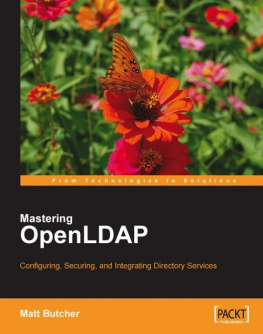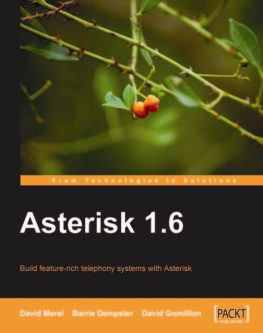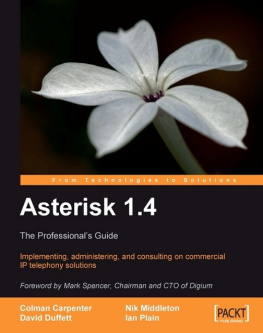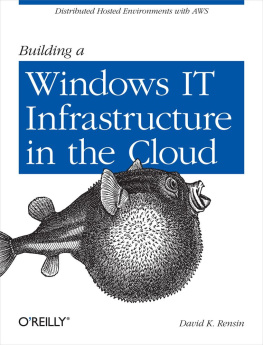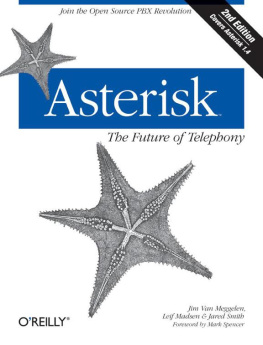Asterisk: The Definitive Guide
Leif Madsen
Jim Van Meggelen
Russell Bryant
Copyright 2011 Leif Madsen, Jim Van Meggelen, and Russell Bryant
OReilly books may be purchased for educational, business, or sales promotional use. Online editions are also available for most titles (.
Nutshell Handbook, the Nutshell Handbook logo, and the OReilly logo are registered trademarks of OReilly Media, Inc. Asterisk: The Definitive Guide , the images of starfish, and related trade dress are trademarks of OReilly Media, Inc.
Many of the designations used by manufacturers and sellers to distinguish their products are claimed as trademarks. Where those designations appear in this book, and OReilly Media, Inc., was aware of a trademark claim, the designations have been printed in caps or initial caps.
While every precaution has been taken in the preparation of this book, the publisher and authors assume no responsibility for errors or omissions, or for damages resulting from the use of the information contained herein.

O'Reilly Media
Theres more than one way to do it. Ive been working with Asterisk for nine years, and this motto becomes more true with each release, each added feature, and each clever person who attacks a telecommunications problem with this incredibly flexible toolkit. I had the fantastic opportunity to work as the community manager for the Asterisk project at Digium for two years, which gave me one of the best vantage points for seeing the scope and imagination of the worldwide development effort pushing Asterisk forward. The depth and breadth of Asterisk is staggeringinstallations with hundreds of thousands of users are now commonplace. I see Asterisk making deep inroads into the financial, military, hospital, Fortune 100 enterprise, service provider, calling card, and mobile environments. In fact, there really arent any areas that I can think of where Asterisk isnt now entrenched as the default choice when there is a need for a generalized voice tool to do stuff.
Asterisk has been emblematic of the way that open source software has changed businessand changed the world. My favorite part of any Asterisk project overview or conference talk is answering questions from someone new to Asterisk. As I continue to answer Yes, it can do that, I watch as the persons eyes grow wide. The person starts to smile when he really starts to think about new things to do that his old phone or communication system couldnt possibly have done. Radio integration? Sure. Streaming MP3s into or out of phone calls? OK. Emailing recorded conference calls to the participants? No problem. Integration of voice services into existing Java apps? Easy. Fax? Instant messages? IVRs? Video? Yes, yes, yes, yes.
The affirmative answers just keep flowing, and at that point, the best thing to do is to sit the person down and start showing him quick demonstrations of how Asterisk can be quickly deployed and developed. Then, I typically point the person toward the first edition of this book, Asterisk: The Future of Telephony , and set him loose. In just a few hours of development (or longer, of course), companies can change the way they deliver products to customers, nonprofits can overhaul how their users interact with the services they offer, and individuals can learn to build a perfectly customized call-handling system for their mobile and home phones. Asterisk scales up and down from individual lines to vast multiserver installations across multiple continents, but the way to start is to install the package, open up some of the configuration files, and start looking at examples.
From the basic beginnings of a PBX that Mark Spencer coded in 1999, the Asterisk project, with the help of thousands of developers, has moved from simply connecting phone calls and has matured into a platform that can handle voice, video, and text across dozens of virtual and physical interface types. The creation and growth of Asterisk were the inescapable results of the convergence of the four horsemen of the proprietary hardware apocalypse: open source development ideas, the Internet, Moores Law, and the plummeting costs of telecommunications. Even hardware vendors who may be frightened of Asterisk from a competitive standpoint are using it in their labs and core networks: almost all devices in the Voice-over-IP world are tested with Asterisk , making it the most compatible system across vendors.
At a recent communications conference I attended, the question Who uses Asterisk? was posed to the 1000-plus crowd. Nearly 75 percent raised their hands. Asterisk is a mature, robust software platform that permeates nearly every area of the telecommunications industry and has firmly cemented itself as one of the basic elements in any open source service delivery system. I tell people that its reasonable for anyone delivering services both via phone and web to want to add an A for Asterisk to the LAMP (Linux, Apache, MySQL, [Perl/Python/PHP]) acronym, making it LAAMP. (LAMA-P was another option, but for some reason nobody seems to like that versionI dont know why.)
The expansion of this book to include more examples is something Ive been looking forward to for some time. Asterisk is accessible because of the ease with which a novice can understand basic concepts. Then it continues to succeed as the novice becomes a pro and starts tapping the other ways to do it with more sophisticated implementations, using AGI with Java, Perl, or Python (or one of the other dozen or so supported languages), or even writing her own custom apps that work as compile-time options in Asterisk. But the first step for anyone, no matter what his or her skill level, is to look at examples of basic apps others have written. Leif, Jim, and Russell have not only put together a fantastic compendium of Asterisk methods, but they have also provided an excellent list of examples that will let the novice or expert quickly learn new techniques and more than one way to do it.
Asterisk 1. x is fantastically powerful and can solve nearly any voice problem you might have. For those of you building the most complex installations, there is even more interesting workwhich will be realized quite soonin development. The currently-in-development Asterisk SCF (Scalable Communications Framework) is being built as an adjunct open source project to allow Asterisk 1. x systems to scale in even more powerful waysstay tuned, or better yet, get involved with the project as a developer.
If youre an experienced Asterisk developer or integrator, Im sure this book will have a few Hey, thats a neat way to do it! moments for you, which is one of the joys of Asterisk. If this is your first project with Asterisk, Id like to welcome you to the huge community of users and developers dedicated to making Asterisk better. This book will take you from a vague idea of doing something with computers and voice communication to the point where youre able to stun everyone you know with your phone systems sophisticated tricks.
Youre encouraged to participate in the online mailing lists, IRC chatrooms, and yearly AstriCon conference that provide up-to-the-second news and discussion surrounding the project. Without your interest, input, and code, Asterisk wouldnt exist. Open source projects are hungry for new ideas and excellent contributions: I encourage you to be a participant in the Asterisk community, and I look forward to seeing your questions and examples in the next edition of this book.


